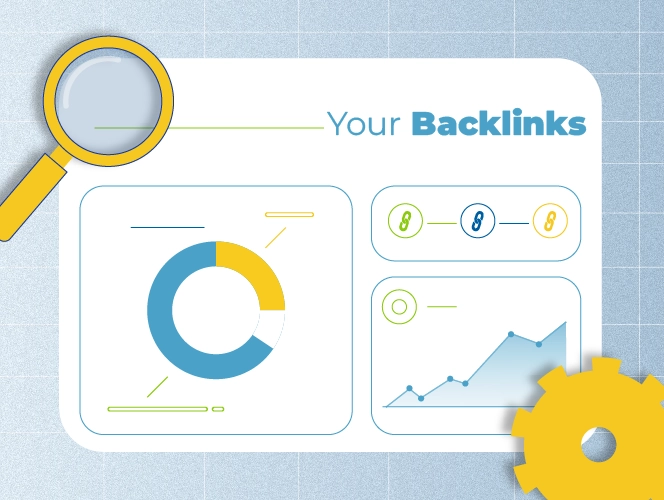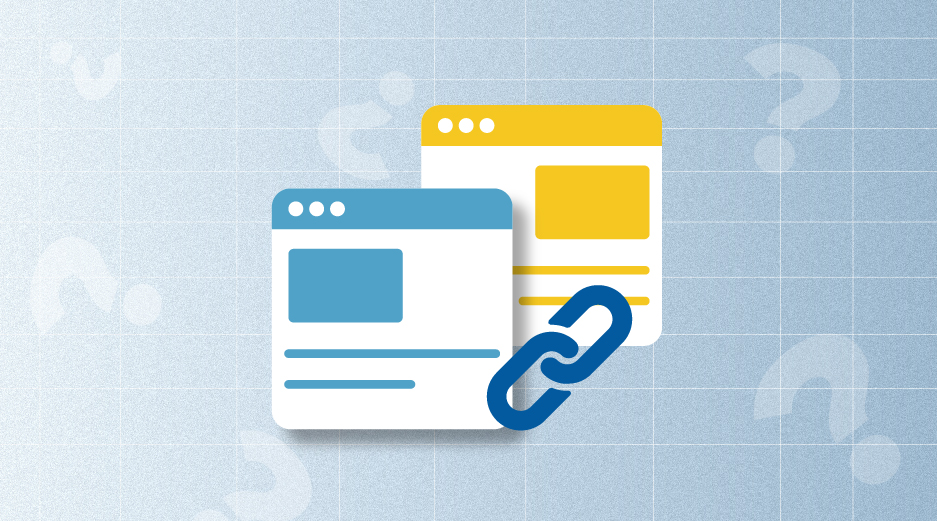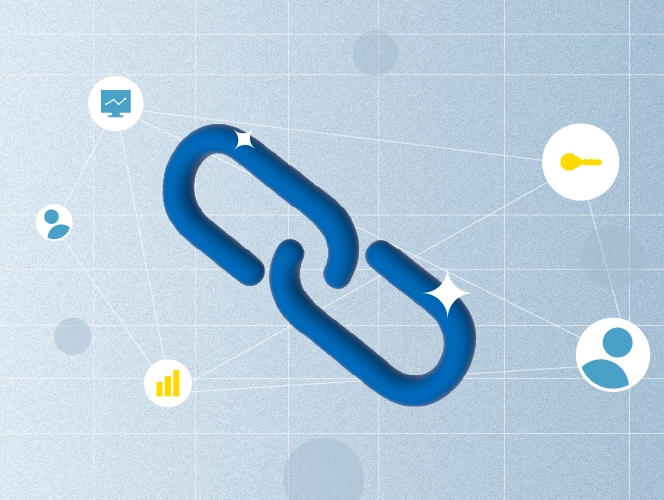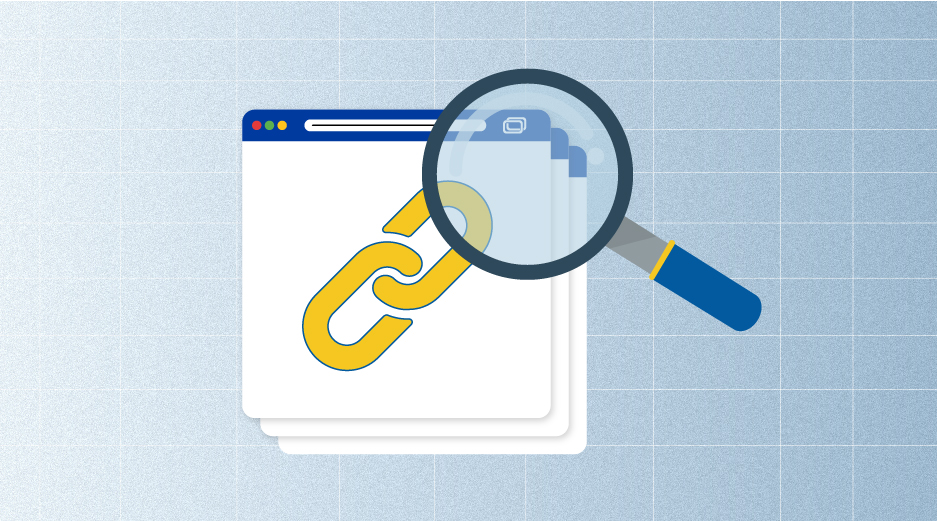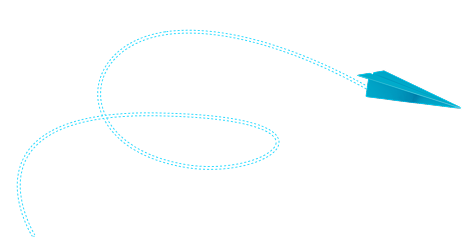We all know how important it is to keep an eye on your website’s backlinks.
At the heart of it, backlink monitoring is about making sure the links pointing to your website are relevant. Without proper monitoring, you might miss issues that could hurt your SEO.
That’s why we always stress how important it is to regularly track your backlinks. And to do that effectively, using the best backlink checker tool is a must. These help you stay on top of the quality and health of your backlink profile.
But, before we jump into how to monitor backlinks it is important to learn what backlinks are.
So, let’s dive into how we can help you effectively monitor your backlinks and make sure they’re working in your favor!
What Is Backlink Monitoring?
Backlink monitoring is the process of keeping track of all existing backlinks and assessing their quality.
If there are any harmful or irrelevant links, you can easily identify and either fix or remove them. It is an important part of SEO specialists’ jobs. However, it is an ongoing process if you want long-term success.
Instead, you have to continuously learn how to manage your backlinks, resolve issues related to them, and build better ones over time.
So, this is how we approach it, and it’s the key to staying ahead in SEO.
Why Should You Monitor Backlinks?
As you already know, backlink monitoring is a key part of maintaining a strong SEO strategy. But a common question that comes up is, “How many backlinks do I need?” The truth is, there isn’t a one-size-fits-all answer. What’s more important than the number is the quality and relevance of the backlinks.
So, here’s why we believe it’s so important to monitor your backlinks:
Identifying Spammy Backlinks
The first essential part of backlink monitoring is identifying spammy backlinks. Our SEO specialists always remind clients that not every backlink is a good one. Sometimes, links come from bad or even spammy websites, and these can actually hurt your SEO.
The first step in identifying spammy backlinks is to regularly monitor your backlink profile and check the spam score using relevant backlinks monitoring tools and software’s like Spam Score Checker. With this, you can find all the suspicious websites linking to your website and assess their quality as well as relevance.
For example, if a link comes from a website with irrelevant content or a bad reputation, it can signal to search engines that your content isn’t reliable.
That’s why it is so important for us. We keep a close watch on all links pointing to your website, making sure none of them come from harmful sources. If we find any bad links, we take action right away—either by removing them or disavowing them. This way, we protect your website’s reputation and keep your SEO strategy strong.
This is especially important because spammy links can drag your ranking factor down without you even realizing it.
Tracking Removed Backlinks
The second important part of backlink monitoring is keeping track of lost backlinks. Over time, backlinks can disappear. Maybe the website that linked to you is no longer active, or the owner decided to remove the link for some reason. So, how do we stay on top of this? We continuously monitor backlinks to catch these changes early.
Let’s say a high-authority website links to your blog post, giving you a boost in traffic. But months later, traffic suddenly drops. One possible reason? That link is gone.
So, by monitoring your backlinks, we can easily identify these removals and take action—whether it’s finding a new link or figuring out how to make up for the lost traffic.
Evaluating the Impact of Your Backlinks
The third key part of backlink monitoring is making sure your backlinks actually add value. Just because you have backlinks doesn’t mean they’re all delivering value.
For example, let’s say a well-known blog links to your product page. That sounds great, but if no one is clicking the link or visitors leave your site quickly, it’s not really helping your SEO.
That’s why we don’t just track backlinks—we analyze their impact.
If we notice that some backlinks aren’t delivering the expected results, we take action. We’ll look for ways to optimize those links—maybe by refreshing the content on those pages or reaching out for new, more effective backlinks.
Tracking Which Websites Link to You
Another key reason why backlink monitoring matters is knowing exactly who is linking to your website. Our SEO specialists always stress the importance of this because not all links are created equal.
For instance, if a well-known and respected website in your industry links to your page, it’s a huge positive for your SEO.
But if the links are coming from random or unrelated websites, that can be less helpful for your SEO.
Making Sure Your Best Links Are Do-Follow
These links allow search engines like Google to recognize and credit your website, helping improve your rankings.
In contrast, no-follow links contain a rel=”nofollow” tag, which tells search engines to ignore them. And, according to an Ahrefs’ study, 10.6% of all backlinks to the top 110,000 websites are no-follow. They don’t contribute to your website rankings in search engines.
So, pay attention to the nature of your links.
We always check whether important links are do-follow. Most links are do-follow by default, but it’s always good to verify—especially for guest posts or links from external sources. However, just having do-follow links isn’t enough; they also need to come from reputable, relevant websites.
If we detect poor-quality do-follow links, we take action. This could mean reaching out to webmasters to remove harmful links or using Google’s “disavow” tool to prevent bad links from affecting your SEO.
By carefully managing your backlink profile, we ensure that every link adds value and contributes to your website’s success.
Align The Anchor Text With Backlinks
So, when it comes to building backlinks, the anchor text is an important element that hugely affects the link’s relevance and impact. Today, it is more than important to make sure anchor text aligns with the context of the linking page and the destination page to maximize your SEO efforts.
The anchor text should precisely describe the content of the destination page and provide clear context to both your readers and search engines. It should be clear and reflective of the linked keywords or topic.
To ensure your anchor text aligns with the context, carefully examine both the linking and destination pages. Analyze different keyword types, topic, and overall context to identify suitable anchor text that accurately represents the content being linked.
It is advised not to use generic or vague anchor text that provides little information to users and search engines. Understanding types of anchor text can help you choose the most effective option for each link.
So, when you ask how to monitor backlinks, it’s all about keeping track of the health of your backlink profile. It’s a continuous process that helps ensure your SEO stays on track and that your website is always performing at its best.
This is how we manage backlinks for our clients.
How We Monitor Backlinks for Better Results
So, to ensure that your backlinks continue to drive results, we use the best backlink checker tools and strategies. Our approach is simple but effective. Let’s take a closer look at how we do it.
Using Ahrefs
Ahrefs is a fantastic SEO tool that works wonders as a backlink monitoring tool. It helps you track all your backlinks, dive into keyword research, and keep an eye on your website’s performance.
With this backlinks monitoring tool, you can easily stay on top of your backlink game and make sure your SEO is always heading in the right direction. To make the most of this tool, it’s vital to understand key SEO terms; refer to an SEO glossary for helpful definitions if needed.
But how to check backlinks with Ahrefs?
Also, by using Ahrefs’ Rank Tracker, you can follow keywords that are of high importance as well as check their backlink profile. Here’s how we use it to make sure your backlinks are working their magic:
Finally, we dive into the Domain Rating (DR), traffic stats, and anchor text to fully understand the impact of each link.
First, we go to the “Backlinks” section, where we can see all the backlinks pointing to your website.
To keep things relevant, we check the history by selecting “Last month,” so we’re always looking at up-to-date data.
We use filters to narrow down the results and make sure we’re focusing on the right types of links—like applying the “Nofollow” filter to spot non-valuable links.
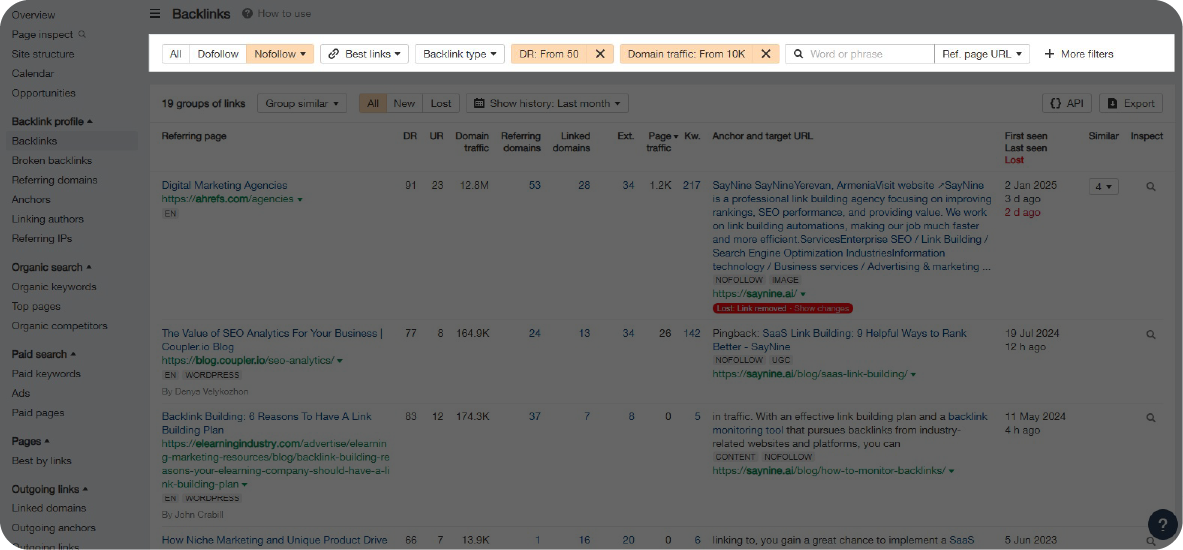
Here’s a screenshot of the filtered backlinks—this helps us quickly spot the most relevant links and understand their impact on your website.
So, this method helps us ensure your backlinks are strong and relevant using the best backlink monitor software out there.
Keeping Track of Backlinks with a Live Google Sheet
One of the core ways we handle backlink monitoring is by keeping a Google Sheet for every client. Why do we do it this way? Because it keeps everything clear and organized.
With a Google Sheet, we can easily see which backlinks are active, check their quality, and note any changes over time. This makes backlink monitoring much more efficient, as we can quickly identify any toxic or broken links that need attention.
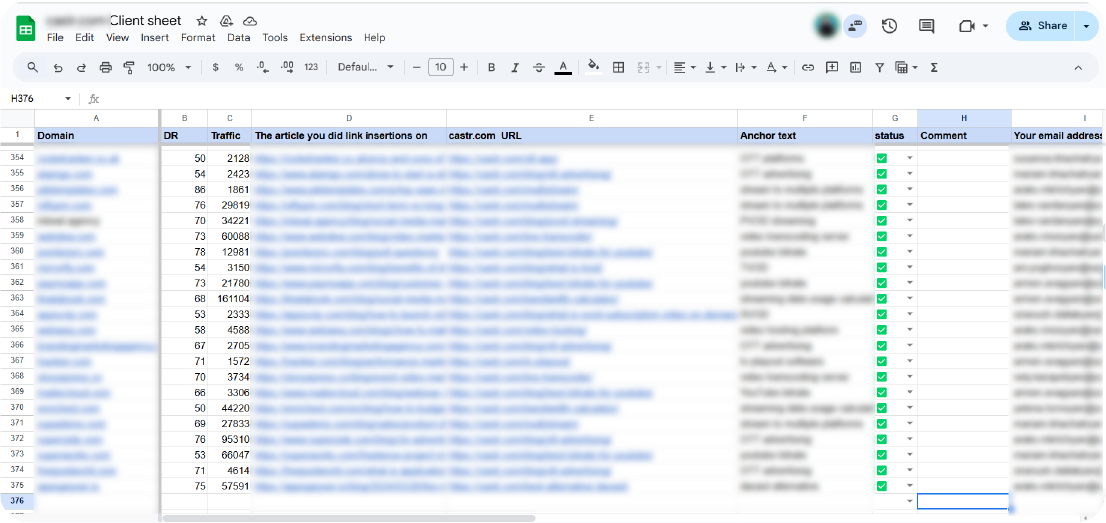
Here, you can see the screenshot showcasing how we track and organize backlinks in a Google Sheet for clarity and efficiency.
Regular updates ensure we stay on top of your backlink profile, helping us make informed decisions about how to manage your backlinks effectively.
Conclusion
So, to wrap things up, backlink monitoring is super important for keeping your SEO strategy on track. When you use the right tools and stay on top of things, you can make sure your backlinks are working in your favor.
Here’s a quick summary of what we do with backlink monitoring:
- A few strong backlinks are better than tons of weak ones.
- Regularly check for spammy links that might hurt your SEO.
- Use backlink monitoring tools to keep an eye on your backlinks.
- Make sure your best links are do-follow so they boost your rankings.
- Keep everything organized with something simple.
I hope our insights will work for you and help you take your backlink monitoring to the next level!
FAQs About Backlink Monitoring
How do I know if a backlink is good or bad?
A good backlink comes from a relevant, high-authority website. A bad one might be from a spammy website, potentially hurting your SEO.
How often should I check my backlinks?
We recommend checking your backlinks regularly, at least once a month, to stay on top of any changes and identify issues early.
How often should I monitor backlinks?
We recommend checking your backlinks regularly, at least once a month, to stay on top of any changes and identify issues early.
How long does it take for backlinks to improve SEO?
It varies. Some backlinks show results quickly, while others take time. Generally, it takes a few weeks to a few months for the full SEO impact.
Can I get penalized for having too many backlinks?
If you use spammy practices to get backlinks, such as buying them or getting irrelevant ones, yes, you could get penalized by search engines.
Quiz Time
Let's put your knowledge to the test.
Leave your email below to get a SayNine certificate!
Are you sure?


